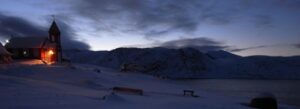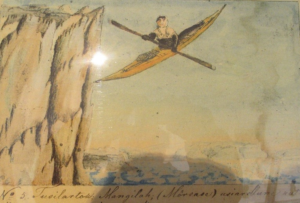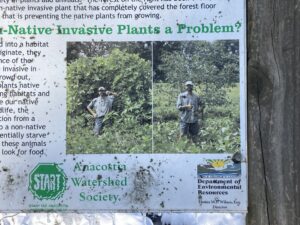
EXT. IN THE SKY OVER GREENLAND – NIGHT
Byron is wedged into an Inuit kayak being blown through a fierce storm. He cannot see what is ahead of him, or what is below, but the air is drenched with the smell of the sea. He has a paddle but can’t navigate with it. The kayak is at the mercy of the storm and the ride becomes wilder, more erratic, sending him sharply higher then crashing down, twisting and jerking from side to side. He drops the paddle, clutches the sides of the small craft.
Suddenly, a cliff emerges from the storm. It is certain the kayak will crash into it. Byron begins to sing.
Byron
When I get to the bottom, I go back to the top of the slide
And I stop, and I turn, and I go for a ride
And I get to the bottom, and I see you again!
At the last moment, the kayak veers away, screaming along parallel to the cliff face. It dips momentarily toward the ocean below then rockets up dangerously close to the shoals.
Byron
Well, do you, don’t you want me to make you?
I’m coming down fast, but don’t let me break you
Tell me, tell me, tell me your answer!
The kayak lands suddenly on a snow-covered landscape beside the Old Church in Upernavik. The church is brightly lit inside, glowing under a cloudless night several degrees above the polar circle. Byron extracts himself from the kayak, approaches a window on the side of the church.
Inside, Buck and Salamina stand before the altar of the church. They are dressed in traditional Greenlandic celebratory attire: he has a white anorak and black dress pants. She wears white sealskin boots that reach over her knees, colorful leggings, a purple blouse and vibrant yoke of beads. They speak to one another, though Byron can’t hear them. He pounds on the window frame to no avail.
Byron goes around to the entrance, opens the door.
INT. OLD CHURCH – NIGHT
Byron enters the church. A large green worm, three feet in diameter, 20-feet long lies on the altar, encircling Buck and Salamina. It is at rest. The couple stop speaking to one another, turn to face Byron, not startled by his appearance.
Byron
What are you doing?
Buck
Just a little ritual, boy.
Salamina (in English)
We love each other.
Byron
You can’t do this. You’re married to my mother.
Buck
She’s not here, son.
Byron
You don’t just leave your family behind.
Buck
No? What are you doing?
Byron
What happens when you go home?
Buck
It’ll sort itself out.
Buck and Salamina turn to face each other again, their four hands joined. They exchange solemn vows in Greenlandic, speaking low and quietly, the way Greenlanders do.
Byron
You can’t do this.
As Byron approaches the couple, Buck faces him, still holding hands with Salamina.
Buck
Are you sure you can do this?
The green worm rolls its head to the side, allowing Byron to step onto the altar. Suddenly, he is alone with Salamina, there is no sign of Buck. She locks arms with him and the worm begins to writhe, its innards grumbling gruesomely.
Salamina
We have to get out of here.
The worm begins to coil closer to them. Salamina hands Byron an Inuit harpoon and hunting knife. He plunges the harpoon into the worm. It reacts violently, shrieking, guts and blood pouring out on the floor, tightening itself around their legs. Byron begins to hack furiously at it with the knife, hot blood spraying in his face. The noise becomes unbearable, drowning out Salamina’s cries, the walls of the church begin to shake from the violence within.
Byron continues slashing at the beast, which offers a final howl and then begins to die. He drops the knife, takes Salamina by the hand, and leads her off the altar and toward the entrance to the church. Windows are blown in by a fierce storm. The door is ripped from its hinges, sucked into the maelstrom outside as the two of them step into oblivion.
INT. ARTIST’S RESIDENCE – MORNING
Salamina and Byron are having breakfast. Through the window, clear skies over frozen Baffin Bay. Salamina sips her coffee thoughtfully, rests it on the table.
Salamina
Tanks you.
Byron
Thank you.
Salamina
Angakok …
Byron interrupts.
Byron
You are angakok, the shaman. Not me.
Salamina shakes her head. She looks away, embarrassed, and gushes forth in Greenlandic, then in Danish, quivering with frustration at not being able to tell him what she wants to say. Byron listens attentively.
Byron
I wish I understood. I wish I could tell you that I saw you and Buck together happy last night,
that I tried to help you. That I woke up this morning suddenly afraid that I could have
killed someone in a blackout rage. I … I wish I could tell you that.
Byron gets an idea, digs into his backpack and retrieves a small notepad and pen. He writes a message to Salamina, tears the page from the notepad and hands it to her.
Byron
Someday, ask someone to translate this to Greenlandic.
Salamina looks at the note, nods her head, and gestures for the pen and pad. She writes for a few minutes, tears the page from the notepad and slides it across the table to Byron.
Salamina
Make English.
Byron looks at the incomprehensible language in a flowing hand.
Byron
I’ll try.

 Four young men face numerous setbacks and detours on a cross-country road trip.
Four young men face numerous setbacks and detours on a cross-country road trip.

